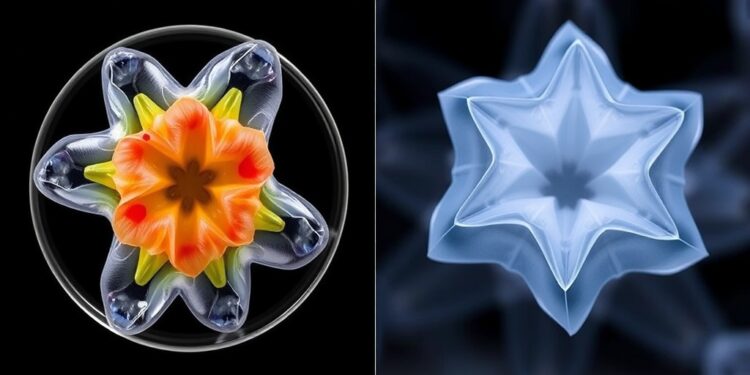A revolutionary breakthrough in regenerative medicine is paving the way for enhanced skin regeneration through innovative bioprinting technology. A research team led by Assistant Professor Byoung Soo Kim from Pusan National University in Korea has developed a sophisticated approach to creating adipose tissues that significantly elevates their potential for therapeutic use. Their novel findings, published in the esteemed journal Advanced Functional Materials, outline how three-dimensional (3D) bioprinting can be harnessed for improved skin repair mechanisms, igniting excitement in the medical community and laying the groundwork for future applications in precision medicine.
The adipose tissue, often overlooked as merely a reservoir of energy, serves a far more complex role as an endocrine organ. It releases various bioactive molecules that can facilitate the repair of other tissues, notably skin. This research underscores the potential for reengineering adipose tissues, making them powerful allies in regenerating damaged organs. The advent of 3D bioprinting represents a significant turning point, allowing scientists to fabricate engineered organs and tissues that mimic the intricate structures found in nature.
Historically, methods of tissue biofabrication have struggled to replicate the unique architecture and densely packed lipid droplets characteristic of natural adipose tissues. Assistant Professor Kim and his lab recognized this challenge and took it upon themselves to fill the void with an innovative biofabrication technique. Their study, available online since February 2, 2025, introduces a hybrid bioink composed of 1% adipose-derived decellularized extracellular matrix and 0.5% alginate. This blend specifically curtails the migration of preadipocytes, while simultaneously promoting their differentiation into functional fat cells.
In scientific terms, the study gives insight into the threshold diameter for adipose units that must be adhered to—preferably less than or equal to 600 µm—to ensure adequate nutrient and oxygen delivery within the bioprinted constructs. The importance of optimal spacing—set at a maximum of 1000 µm—between the adipose units is emphasized as a crucial factor that fosters adipogenesis. The implications of this arrangement are profound, leading to enhanced paracrine signaling which, in turn, facilitates a flourishing environment for skin cell migration.
The in vitro component of their research revealed striking results through modulating expression levels of cell migration-related proteins. This highlights how the bioprinted adipose tissues not only serve their standard role but also take on an active role in skin regeneration processes. The proteins involved—MMP2, COL1A1, KRT5, and ITGB1—play significant roles in wound healing and tissue repair mechanisms, effectively turning the engineered tissues into active agents of regeneration.
As the research progressed into in vivo studies, the team developed a tissue assembly that incorporated both adipose and dermal modules. This assembly was subsequently implanted into mouse models with skin wounds. The findings from this phase demonstrated that the novel tissue assembly accelerated wound healing significantly, characterized by re-epithelialization and enhanced remodeling of tissues, not to mention improved vascularization. The expression of skin cell differentiation-related proteins was meticulously regulated, validating the functional efficacy of this groundbreaking approach.
The current advancements in bioprinting technology signal a paradigm shift towards a future where customized tissue engineering is commonplace. Researchers expect a burgeoning market for personalized bioprinting systems as healthcare institutions seek innovative methods tailored to individual patient needs. With increased adoption of these personalized solutions, the scope for treating various ailments—especially chronic wounds like diabetic ulcers, pressure sores, and burns—expands drastically.
Furthermore, the implications regarding regenerative medicine arise not merely from the ability to heal wounds, but also from the prospect of improving fat grafting procedures. Currently, fat grafting techniques face challenges such as low survival rates and gradual absorption of grafted tissues. However, the hybrid bioinks developed by Kim’s team show promise in enhancing both endocrine function and overall survival rates among adipose cells, potentially offering a solution to overcome these limitations.
In closing, the study conducted at Pusan National University demonstrates the promising potential of 3D bioprinted endocrine tissues for skin regeneration. As stated by lead author Jae-Seong Lee, the significant impact of this research provides evidence of the practical applications in regenerative medicine, creating optimism for future methods of treatment in various clinical settings. The incorporation of bioprinted adipose tissues as a standard in healthcare innovation signals a transformative period in medical science, fundamentally altering our approaches to healing and restoration.
Ultimately, this pioneering research sheds light on a future where 3D bioprinting does not merely fill gaps but innovates and refines the methodologies of regenerative medicine. As the study continues to gain traction, it holds potential not only for academic exploration but also for real-world healthcare solutions that align with the growing demand for personalized medicine, opening doors to unprecedented therapeutic pathways.
Subject of Research: Animals
Article Title: 3D Bioprinting-Assisted Tissue Assembly of Endocrine Adipose Units for Enhanced Skin Regeneration
News Publication Date: February 2, 2025
Web References: Advanced Functional Materials DOI
References: 10.1002/adfm.202419680
Image Credits: Byoung Soo Kim from National Pusan University, Korea
Keywords: Adipose tissue, Regenerative medicine, Skin regeneration, Tissue regeneration, Endocrine system, 3D bioprinting.
Tags: 3D bioprinting technologyadipose tissue regenerationAdvanced Functional Materials publicationbioactive molecules in adipose tissueendocrine functions of adipose tissueengineered tissue fabricationinnovative medical breakthroughsprecision medicine applicationsPusan National University researchregenerative medicine advancementsskin repair mechanismstissue biofabrication challenges





